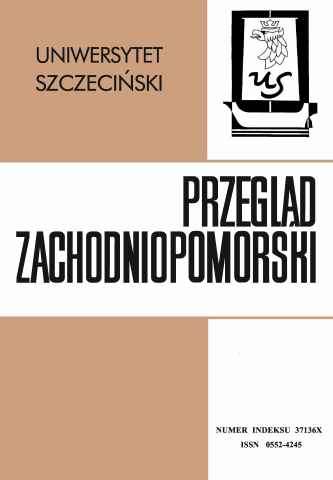Participation of the foreign Waffen-SS and Wehrmacht Units in the war in Western Pomerania during the first months of 1945. Part one
Udział jednostek cudzoziemskich Waffen-SS i Wehrmachtu w działaniach wojennych na Pomorzu Zachodnim w pierwszych miesiącach 1945 roku. Część I.
Author(s): Dariusz WybranowskiSubject(s): History
Published by: Wydawnictwo Naukowe Uniwersytetu Szczecińskiego
Keywords: Western Pomerania; World War II; Waffen-SS; Wehrmacht; foreign volunteers SS
Summary/Abstract: The article presents the units that participated in the fights in Western Pomerania (German: Provinz Pommern) in January and February 1945: the 6th foreign Waffen-SS Division (the 11th Voluntary Armoured SS Division Nordland, the 15th Grenadiers’ Division Lettland, the 23rd Voluntary Armoured Grenadiers’ SS Division Nederland, the 27th Voluntary Armoured Grenadiers’ Division Langemarck, the 28th Voluntary Armoured Grenadiers’ Division Wallonien, the 33rd Grenadiers’ SS Division Charlemagne) and anti-Stalinist units of the 1st Division of the Russian Liberation Army (ROA), which was part of the so-called Własow Army. At the beginning there is a presentation of the genesis of the armed forces of the SS composed of West-European volunteers (Danes, Norwegians, Swedes, Finns, Frenchmen, Belgian Walloons and Flemings), the profiles of some of their leaders, the structure of the forces and the sites of some earlier battles (especially during the period of 1943–1944) against a wider background of the Pomeranian operations of the Red Army and the units of the 1st Polish Army. Later there is a presentation of the military situation at the end of 1944 and the beginning of 1945 and the effects of the January offensive of the Red Army, as well as the circumstances of how the foreign units of the Waffen-SS reached Western Pomerania and how they were reconstructed (the 15th SS Division Lettland) and their initial battle operations. The first chapters depict the battle operations of the units of the 15th Latvian SS Division Lettland on the ‘Pomeranian Embankment’ and later near Kamień Pomorski, and the fate of the units after the defeat in Western Pomerania. One of the episodes described in detail is the war crimes against the Polish soldiers who had been taken captive at the beginning of February 1945 in the village of Podgaje (German: Flederborn) committed by either Latvian SS-men or the Dutch ones from the Division Nederland. The first chapters also depict the battles fought by the 33rd French SS Division Charlemagne on its combat trail from Szczecinek (German: Neusttetin) to Białogard on the Parsęta River (German: Belgard) and Karlino (German: Körlin), and in defence of the Twierdza Kołobrzeg (German: Festung Kolberg; English: Kolberg Stronghold). In the background there are other military operations in Pomerania, among other things the defeat of the 10th SS Army Corps or the battles in retreat between Dziwnów (German: Dievenow) and Trzęsacz (German: Haff). These descriptions have been supplemented with the presentation of the battles fought by the units of the 1st Division of the ROA (S.K. Bunjaczenko was its commander but it was subordinated to Wehrmacht) along the Oder, including – among other things – groups of tank destroyers at Gozdowice (German: Güstebiese) and South of Szczecin, as well as on the combat trail of the Własow Army from Brandenburg, through Lusatia (Polish: Łużyce), to Czechoslovakia, where the Army finally ceased to exist.
Journal: Przegląd Zachodniopomorski
- Issue Year: 29/2014
- Issue No: 04
- Page Range: 69-123
- Page Count: 1

